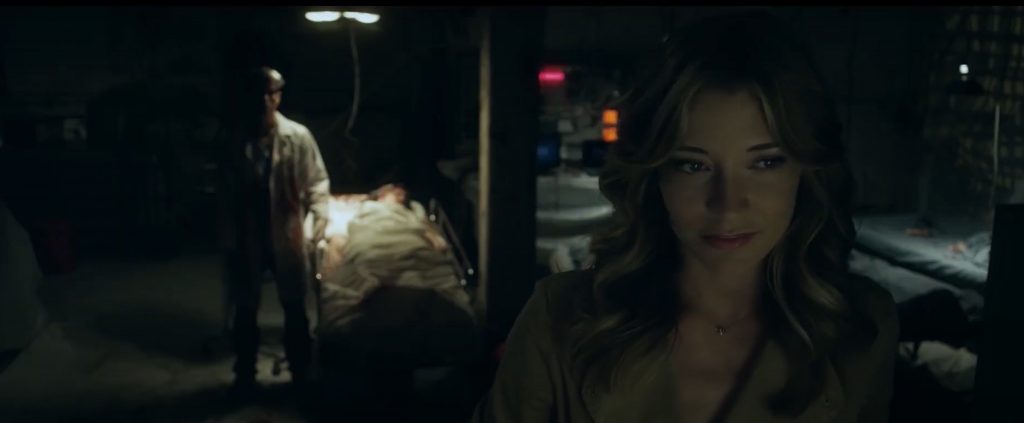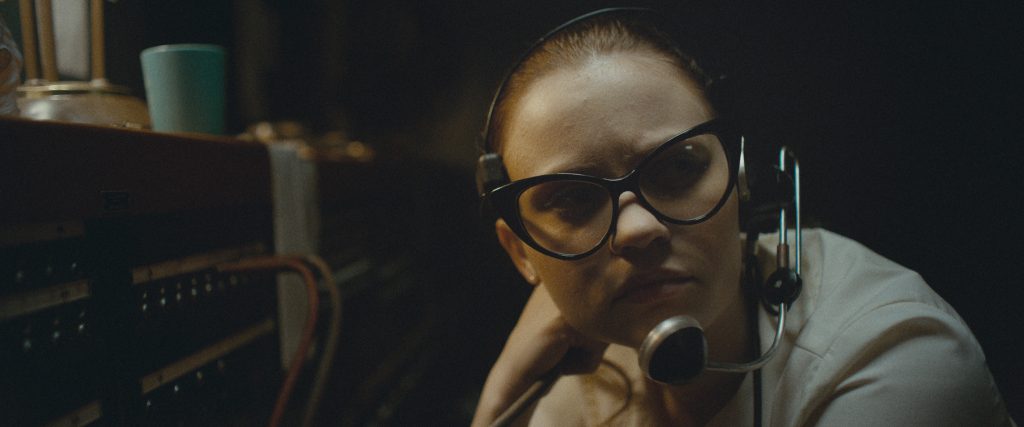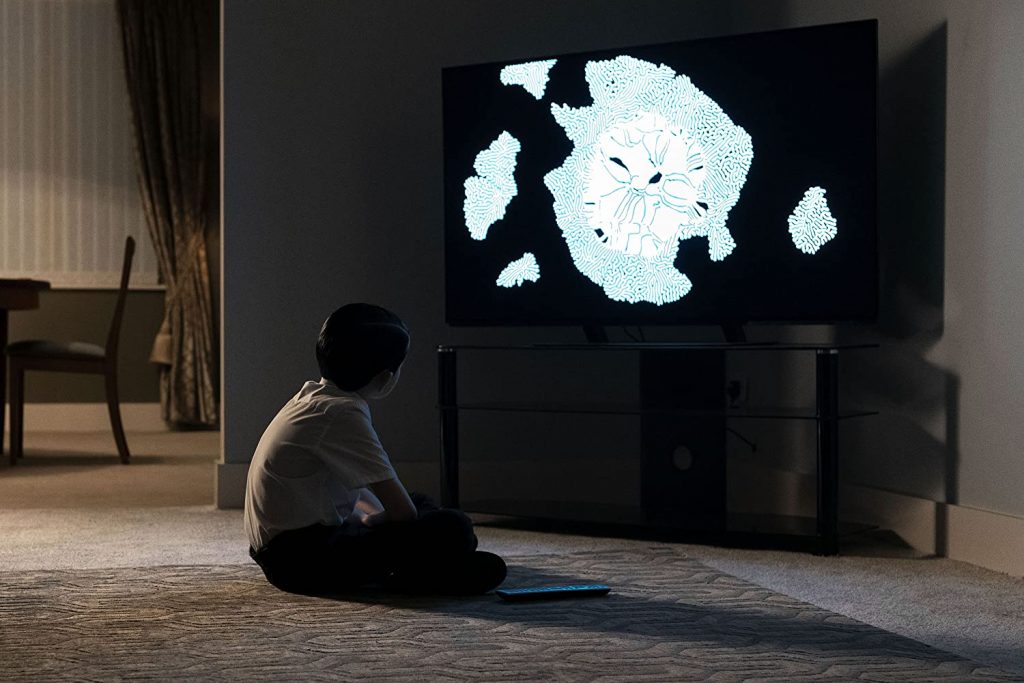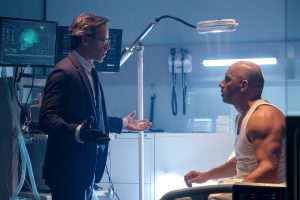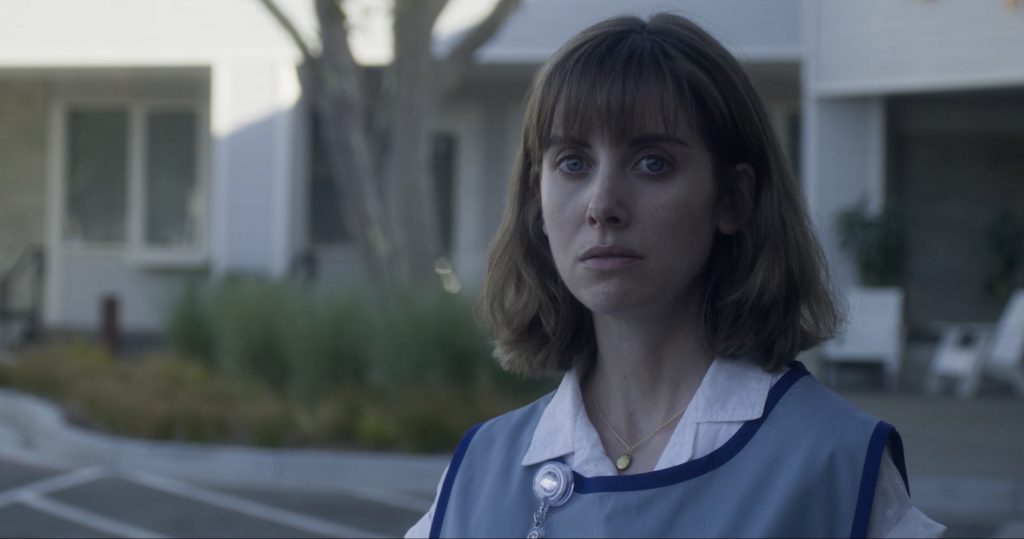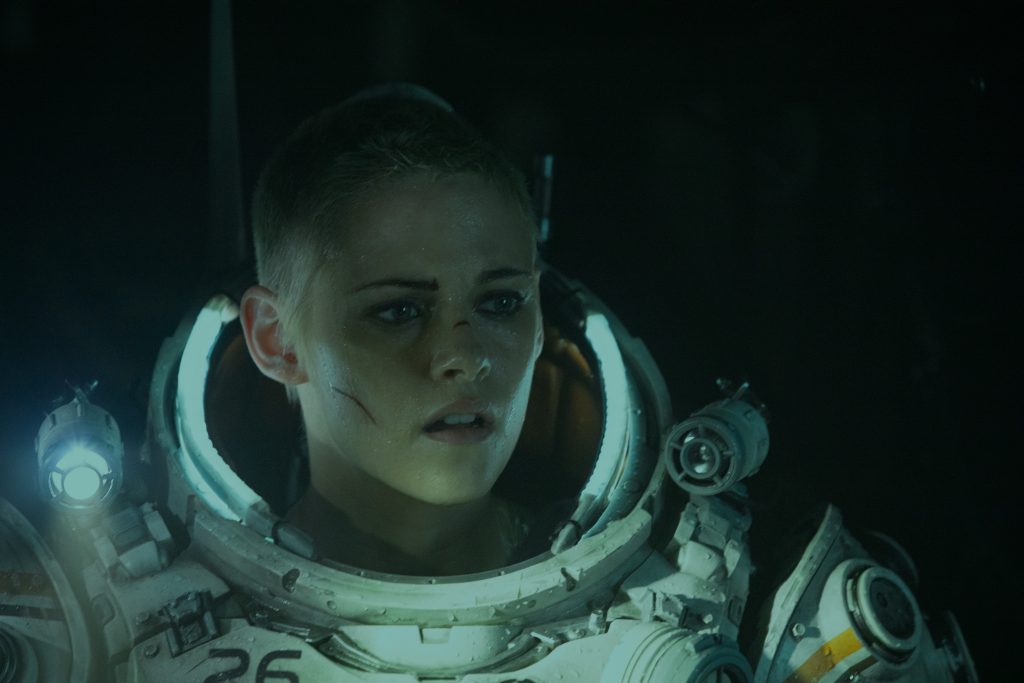June 25, 2020
by Carla Hay

Directed by Gil Junger
Culture Representation: Taking place in an unnamed U.S. city and in Beijing, the comedy/drama “Think Like a Dog” features a racially diverse cast (mostly white and Asian) representing the middle-class and wealthy.
Culture Clash: A 12-year-old American boy who’s an aspiring inventor and his online gaming friend in China secretly find a way to make a device that gives people the ability to hear what a dog is thinking, but government officials want to get ahold of the device, while the boy is dealing with family drama at home, because his parents are on the verge of divorce.
Culture Audience: “Think Like a Dog” will appeal primarily to families with children younger than the age of 10.

Even though the comedy/drama “Think Like a Dog” is set in the early 21st century, there’s something very 1970s quaint about this “talking dog” movie, which has simplistic and preachy messages that are both endearing and annoying. Adults will know exactly how this formulaic movie is going to end, but very young kids (under the age of 10) could enjoy this ride, since the children in this movie are very relatable.
“Think Like a Dog” (written and directed by Gil Junger) seems like a throwback to the 1970s, when movies about family dogs (such as the “Benji” series and “A Boy and His Dog”) were starting to become very popular. Back in the 1970s, life was less complicated for American children, who didn’t have to deal with school shootings or cyberbullying. It was also a period of time when it was more plausible to have a movie where a boy and his “talking dog” team up for the boy’s plan to keep his parents from divorcing.
The concept of a child being able to save a marriage with the help of a talking dog is a lot for any kid to handle in a movie. But “Think Like a Dog” also throws in another heavy-handed plot of the kid trying to dodge getting in trouble with the government because his invention has interfered with important satellite signals that control the world’s economy. Yes, it’s that kind of movie.
The child prodigy at the center of the film is 12-year-old Oliver (played by Gabriel Bateman), who lives in an unnamed American city that looks like a pleasantly peaceful suburb. Oliver is a science and computer enthusiast, who keeps pictures on his bedroom wall of Elon Musk and a Mark Zuckerberg-like tech mogul named Ram Mills (played by Kunal Nayyar), also known as Mr. Mills. Oliver is an only child. His parents are Lukas (played by Josh Duhamel) and Ellen (played by Megan Fox), who are going through a rough patch in their marriage.
Lukas (who’s a soccer coach at a local high school) and Ellen (who works in a beauty salon) have grown emotionally distant from each other. Ellen and Lukas have been thinking about separating, but they haven’t told Oliver yet. But, of course, Oliver finds out, when he discovers that Lukas has been offered a coaching job at a college named Springfield University, which is a three-hour drive away from where they live, and Ellen isn’t exactly trying to stop Lukas from taking the job. If Lukas takes the job, it’s a way for him and Ellen to separate, and they plan to “figure it out” from there.
Oliver’s best friend is his mixed Border Collie dog Henry (voiced by Todd Stashwick), who has voiceover narration throughout the entire movie. Most of the “jokes” that Henry tells are the type of jokes that have been heard before in other “talking dog” movies that make the dogs sound like low-rent (but family-friendly) stand-up comedians. Henry shares his platitudes about life by saying that most humans don’t know the secret that dogs know: How to be happy.
Henry’s philosophy is that humans are always looking for ways to improve their lives instead of being content with who they are right now. (That’s easy to say, coming from a pampered house dog whose needs are catered to by humans.) What’s kind of contradictory about this movie’s message is that inventions are usually about improving lives, so Henry’s overly simplistic philosophy doesn’t really work when you consider that Oliver is an aspiring inventor.
Oliver spends a lot of time at home playing online virtual-reality games with a teenager in Beijing named Xiao (played by Neo Hooo, also known as Minghao Hou), who is equally passionate about science and computers as Oliver is. (By the way, this movie has a lot of positive references to China since Chinese-funded M-Star International is one of the production companies behind “Think Like a Dog.”)
Oliver and Xiao have never met in person, but they consider each other to be close online buddies. Oliver has been working on an invention that can read people’s thoughts. And lo and behold, Xiao calls Oliver to tell Oliver that he’s found a massive breakthrough in Oliver’s invention, which can be activated by using a massive processor. And to their delight, they find out that the invention works.
At school, Oliver is a typical nerdy type who is shy around a fellow classmate who is his big crush. Her name is Sophie (played by Madison Horcher), who is the typical nice but slightly aloof girl who seems to be almost perfect in every way. And since this movie is extremely predictable, there’s the school bully Nicholas (played by Billy 4 Johnson), who picks on Oliver; the bully’s spineless follower Brayden (played by Dillon Ahlf); and wisecracking student Li (played by Izaac Wang), who’s too precocious for his own good.
The movie has several contrived situations to make Oliver embarrassed in front of Sophie, who seems to be in pretty much all of the same classes as Oliver. The school is doing the play “Romeo and Juliet,” and in rehearsals, Oliver is embarrassed when he says a monologue and, as a Freudian slip, accidentally substitutes the name Sophie for Juliet.
Oliver is also embarrassed when he sees Sophie and her adorable female dog (a poodle mix) at a dog park, and he gets tongue-tied when trying to start a conversation with Sophie. The school bully Nicholas naturally has a big alpha male dog (a greyhound), which the movie portrays as being so popular with the opposite sex that the dog has female dog groupies. Yes, it’s that kind of movie.
But Oliver’s biggest humiliation happens when Mr. Mills comes to town to give a guest lecture at the Young Inventors Expo. At the event, Oliver gives a demonstration of his invention that has the telepathic powers. Someone wears a tech headband that reads the brain, and that person’s thoughts show up on a computer that has a wireless connection to the headband. Oliver asks for a volunteer from the audience, and he foolishly chooses Brayden, who’s a known friend of school bully Nicholas.
Oliver asks Brayden to think of a color, and that color will be named by the computer. The computer results show that Brayden was thinking of the color blue, but Brayden says he was thinking of the color green. Nicholas then stands up in the audience, as people do in movies like this, to make a taunting remark and lead a chorus of laughter at how Oliver’s invention is stupid and doesn’t work. All of this happens in front of Oliver’s idol Mr. Mills.
A crushed Oliver goes home, and his life gets worse when he finds out that his parents are headed toward a separation. What’s a boy whose life is falling apart to do? He goes in his room and finds comfort with his best friend/dog, while viewers of this movie have to watch Henry in voiceover acting like a know-it-all therapist.
It’s just around this time that some satellite gobbledygook happens in the universe, which suddenly allows Oliver to hear Henry’s thoughts through the invention. (Henry ends up wearing a magical telepathic collar, so Oliver can hear Henry’s thoughts through this portable, wireless collar device.) Oliver is elated that he can now hear his best friend talk, but he also knows that if he tells people about it, they’ll think he’s crazy.
Henry is able to communicate these thoughts with Oliver telepathically: “When humans grow up, they start to focus on other things and forget about what matters. What are the two most important things in life? Love and family. We [dogs] don’t complicate things like humans.”
And so, Henry and Oliver hatch a plan to fix Lukas and Ellen’s shaky marriage: “We need to teach Mom and Dad to think like a dog,” Henry says, as if he’s Marriage Counselor of the Year. The “plan” is to remind Lukas and Ellen of their wedding day, by getting them to hear their first wedding dance song at Oliver’s school dance. The idea is that the song will trigger memories of happier times, and then Lukas and Ellen can fall in love again, and everyone can live happily ever after.
Of course, there has to a big dramatic scheme to get Ellen and Lukas in the same room to hear this song. And somehow, Oliver’s school dance is the only place that Ellen and Lukas can hear this song, as opposed to anywhere else where Oliver could easily play the song to his parents. And somehow, Henry is the only living being who can get Lukas and Ellen in the same room at Oliver’s school dance. Yes, it’s that kind of movie.
Meanwhile, Oliver’s invention has messed with the outer-space satellite coordinates that control the world’s banks. And this satellite interference could cause total chaos in the world’s economy. Oliver’s telepathic invention literally ends up on the U.S. government’s radar at a place called the Global Cyber Protection Agency, which can pick up the dog Henry’s thoughts, which are misinterpreted as terrorist thoughts.
Why? Because when Henry thinks about urinating on the lawn of a white house in the neighborhood, the agency thinks it’s the U.S. president’s White House. Therefore, the agency thinks a terrorist is behind the mysterious interference in satellite coordinates. And so, two agents—Agent Munoz (played by Julia Jones) and Agent Callen (played by Bryan Callen)—are dispatched to find this dangerous terrorist, or else the world’s safety could be at stake.
Meanwhile, Oliver gets a big surprise when he’s visited at school by Mr. Mills’ efficient assistant Bridget (played by Janet Montgomery), who meets Oliver outside the school to show him a hologram message from Mr. Mills. In the message, Mr. Mills says he was so impressed with the idea of Oliver’s invention that he has invited Oliver to be his guest at the Tech Summit in China. Oliver says he can’t go to the summit, but he tells Mr. Mills about his friend Xiao, whom Oliver credits with being a big help with the invention.
And so, Xiao becomes Mr. Mills’ guest at the summit, which takes place in Beijing. The event is so over-the-top in treating Mr. Mills like a “god” that a giant projection of his face appears on the steps of the convention center where the event is held. Of course, there’s a plot twist with Mr. Mills, which is revealed in the movie’s trailer, but it won’t be discussed in this review, since we all know how this movie is going to end anyway.
Will Oliver win Sophie’s heart? Will Henry help save the day? Will Lukas and Ellen fall back in love again? Do people need a dog’s brain to know the answers to these questions?
“Think Like a Dog” would have been a better movie if it weren’t so unimaginative and if it weren’t so preachy. The jokes in the movie just aren’t very funny. (There’s an over-reliance on jokes about farting, dog poop and the canine habit of dogs smelling each other’s rear ends.) There’s a lot of the movie that’s been seen and done before in other films about talking dogs or nerdy boys who are social misfits at school.
Some of the cast members stand out as being better actors than others in this movie. Bateman (as Oliver) carries the film with winning charm. Fox (as Oliver’s mother Ellen) is also quite good, and she does her best to act believable in a bland movie. Wang (as the smart-alecky Li) is a scene-stealer, just as he was in the much-raunchier 2019 comedy film “Good Boys.”
But ultimately, these slightly-above-average performances are not enough to save “Think Like a Dog” from too-corny mediocrity. The ways that problems are resolved in “Think Like a Dog” are such moldy concepts from a bygone era, that it’s the equivalent of a dog with mange that needs a good scrub-down bath of today’s reality.
Lionsgate released “Think Like a Dog” on DVD, Blu-ray, digital and VOD on June 9, 2020.


